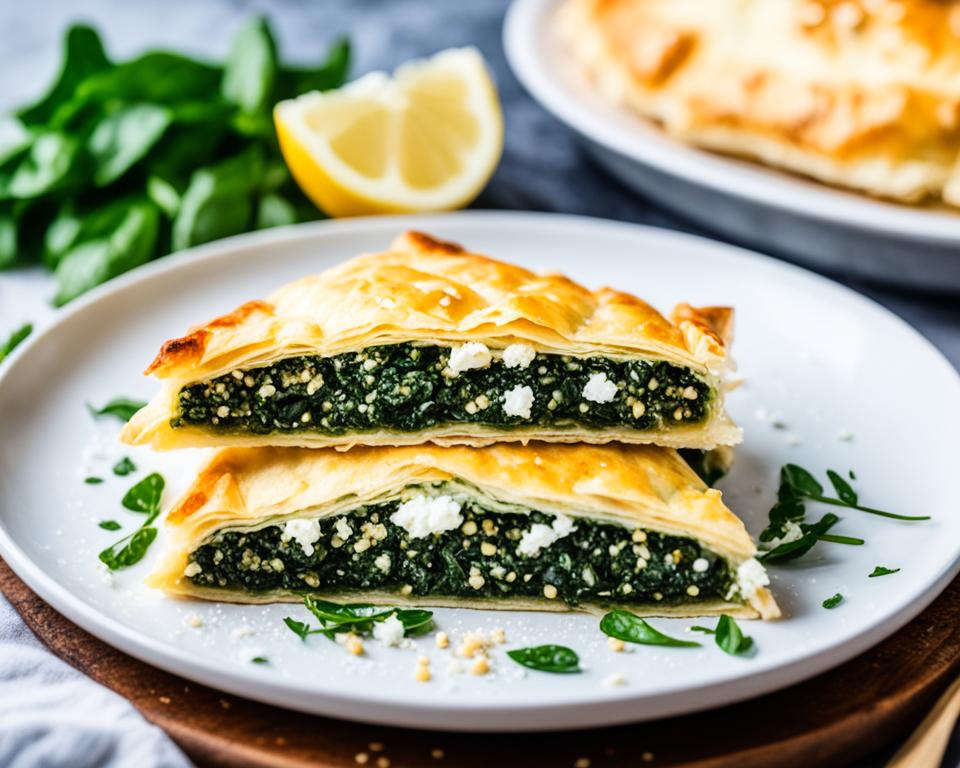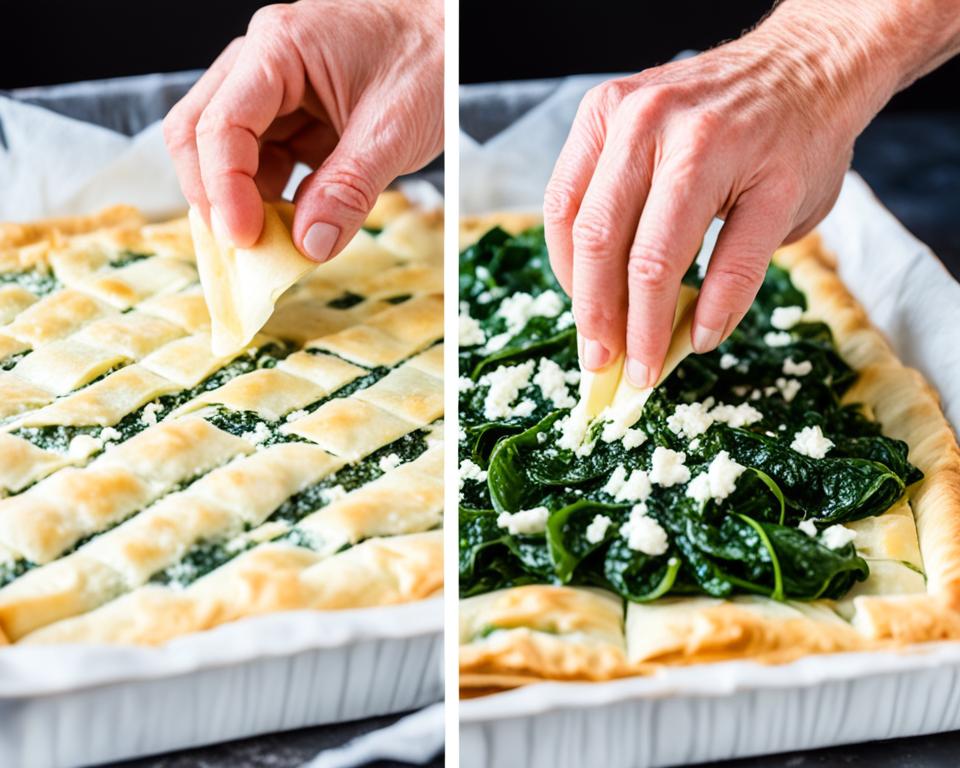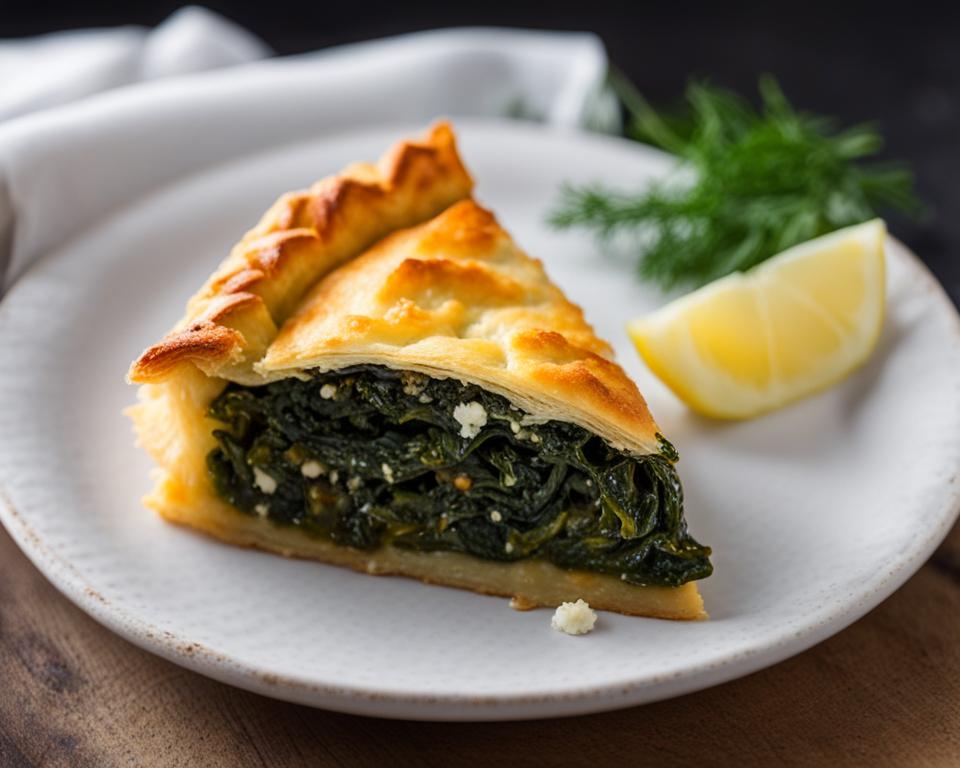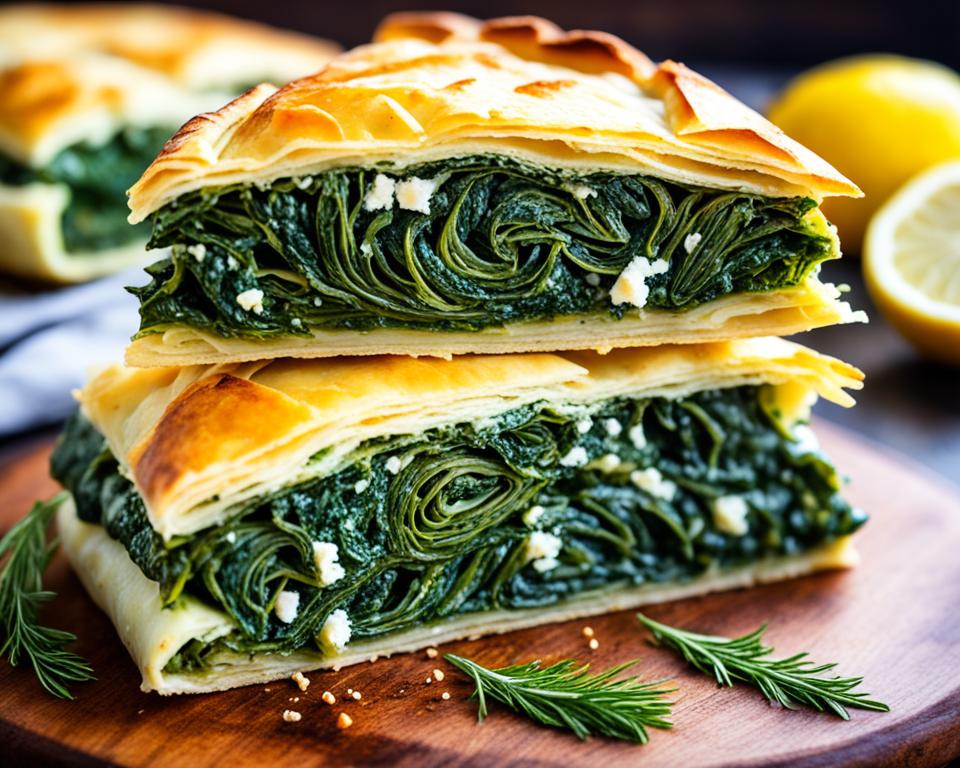Embark on a culinary journey to the Mediterranean with a traditional Greek recipe that promises to delight your palate. This homemade spanakopita, an emblem of Greek cuisine, is the epitome of a savory filling encased in golden, crispy layers savored with every bite. A dish of simplicity and elegance, spanakopita carries the heritage of Greek home cooking to your kitchen, offering a taste that’s both comforting and exquisitely rich. Whether served as a festive side or as the star of your dining table, this flaky spanakopita will transport you to the sun-drenched shores of Greece.
Key Takeaways
- The flakiness of phyllo dough is the hallmark of the ideal spanakopita experience.
- Homemade spanakopita, bursting with traditional Greek flavors, surpasses any store-bought version.
- A harmonious blend of spinach and feta, with a hint of herbs, creates the quintessential savory filling.
- The versatility of spanakopita makes it a perfect fit for any meal, from casual family dinners to celebratory feasts.
- Rooted in Greek cuisine, the dish is not only a treat for the taste buds but also opens a window into rich cultural traditions.
Introduction to Greek Spanakopita
Envision a dish that stands as a pillar of Greek cuisine, a testament to the rich and vibrant culinary culture of the Mediterranean. Spanakopita is this archetype, encompassing the heart of traditional cooking methods and authentic flavors cherished across Greece and beyond. This delectable Greek appetizer is known for the distinctively crispy phyllo dough that envelops a savory filling of spinach and feta, creating a textural masterpiece adored by food connoisseurs globally.
A Cultural Culinary Icon
From the bustling streets of Athens to the serene landscapes of the Cyclades, spanakopita is woven into the fabric of Greek culture. It embodies a sense of hospitality and generosity that is central to the Greek way of life. This iconic spinach pie, as simple as it may seem, carries within its layers a history of family gatherings, festive celebrations, and the everyday pleasures of Greek dining. It’s an homage to a way of cooking rooted in using fresh, natural ingredients to produce flavors that resonate with the soul.
The Perfect Blend of Flaky Phyllo and Savory Filling
There is an art to creating the perfect spanakopita—one that lies in the balance between the thin, buttery phyllo and the rich, cheese-laden spinach core. Each layer is a brush stroke of flavor, come together to showcase a dish that is much more than the sum of its parts. As a sought-after Greek appetizer, its flaky exterior and tender heart make for an unforgettable taste experience, whether it’s relished as a warm welcome at a family meal or savored as a treat at a lively Greek festival.
The allure of Spanakopita lies not solely in its delightful composition but also in its storied heritage—a piece of Greece served on a plate, offering a culinary journey through the authentic flavors that have shaped Greek cuisine for centuries.
- Renowned for its crispy phyllo dough, spanakopita’s texture is a joyful contrast to its hearty interior.
- The filling of spanakopita, a luscious mixture of spinach and feta, exemplifies the spirit of Greek appetizers with its rustic, yet refined palate.
- Making it at home brings not just a dish to the table but an experience steeped in the authenticity and warmth of Greek hospitality.
Spanakopita’s Timeless Appeal
Embark on a gastronomic odyssey that celebrates the humble yet magnificent spanakopita—a storied dish that has graced Greek festivals and family tables with its presence for generations. Beyond its origins, spanakopita has etched a place in hearts worldwide, its layers speaking the language of tradition and togetherness.
Often called the quintessence of Greek comfort food, this easy-to-make pie isn’t just reserved for grand celebrations or local tavernas. With its traditional recipe passed down through families, spanakopita has blossomed into a versatile symbol of culinary prowess that can transform any meal into an occasion.
From Greek Festivals to Family Tables
The fragrant, golden-brown pastries that define Greek festivals have found a permanent and endearing spot in the daily lives of people. Whether it’s a piece of spanakopita enjoyed under the vibrant Greek sun or a comforting family recipe that brings warmth to a chilly evening abroad, the appeal of this dish transcends borders and generations.
A Versatile Dish for Any Occasion
Its simplicity is deceptive, for in every bite lies a complexity of flavor that harmonizes with any meal. The versatility of spanakopita shines through when served as a delectable starter, a robust main course, or even as a snack. This traditional recipe captivates with its flaky pastry and rich filling, making it as suited to a grand feast as to an intimate family gathering.
Whether you’re looking to recreate the excitement of Greek festivals at home or introduce a piece of heritage to your table, spanakopita stands as a testament to the rich tapestry of Greek culinary legacy. It is a dish that promises to enchant with its timeless appeal and easy preparation—truly a recipe to be celebrated, shared, and savored.
What Makes Spanakopita Stand Out
When one thinks of homemade spanakopita, the mind conjures up images of a sumptuous, flaky treat that is deeply rooted in Greek cuisine. This traditional recipe is a blend of simplicity and exquisite taste, a fusion of well-selected, fresh ingredients that form a dish with an unmistakable presence. The standout character of spanakopita is defined both by its impeccably flaky texture and its hearty, savory spinach-feta filling.
The essence of an authentic spanakopita experience lies in mastering the delicate balance between the crispy layers of phyllo dough and the rich stuffing nestled inside. This delectable savory pie, adored in both slice and triangular pastry forms, has been lovingly passed down through generations. It captures the essence of Greek culinary traditions and has become a beloved staple in households not just in Greece, but all around the world.

Quality ingredients are paramount. A good spanakopita requires nothing less than the crispiest phyllo, leafy fresh spinach, and briny, creamy feta to make every bite memorable. The layers of phyllo dough, with their golden hue and rustling texture, are testament to the skill involved in crafting this fine pastry.
| Ingredients | Role in Spanakopita |
|---|---|
| Fresh Spinach | Provides the nutritious, verdant heart of the filling. |
| Quality Feta Cheese | Adds a tangy kick, complementing the greens. |
| Phyllo Dough | Achieves the signature flaky texture of the pie’s casing. |
| Herbs and Seasonings | Enhances the filling with aromatic depth. |
| Olive Oil | Imparts richness and binds the flavors harmoniously. |
The enjoyment derived from this flaky spanakopita is heightened by the knowledge that its creation represents a labor of love. From the careful layering of the phyllo to the assembling of filling, the process is a dance between tradition and personal touch. Every homemade pie varies slightly from the next—each one bearing the mark of the hands that made it and the hearth where it was baked.
“Spanakopita captures the very soul of Greek cuisine, with each layer a whisper of tradition, each bite a testament to homely perfection.”
Indeed, spanakopita stands out not just as a mouthwatering dish, but as a culinary tapestry rich with history and flavor. It is an enduring emblem of traditional Greek cooking techniques and a testament to the universal appeal of well-crafted, simple foods made with the highest quality of ingredients.
The History and Origin of Spanakopita
Spanakopita, a beloved staple in Greek cuisine, has its roots intertwined with the very essence of Greece’s history. As a historical Greek dish with a legacy stretching back to ancient times, spanakopita is not just a culinary delight but also a symbol of the Mediterranean diet’s longevity and pervasive influence on global gastronomy. With each layer of crispy phyllo, this traditional spinach pie unfolds tales of agricultural abundance and familial togetherness, outlining the social fabric of Greek life through the ages.
Deep Roots in Greek Cuisine
At the heart of Greek culinary tradition lies spanakopita—characterized by its flaky texture and rich filling, it has graced many a table during festivals and everyday meals. The Mediterranean diet, renowned for its emphasis on fresh produce and simple yet robust flavors, celebrates dishes like spanakopita that utilize local ingredients such as spinach, feta cheese, and olive oil. These components not only provide nourishment but also represent the agricultural wealth of the region.
Influence on Mediterranean Cooking
Spanakopita’s impact on Mediterranean cooking extends beyond Greece, as this comforting spinach pie has inspired many variations throughout neighboring countries. It stands as a testament to the interconnectedness of food culture across this diverse region, with each variation honoring the original while contributing distinct local flavors. Its popularity underscores the dish’s remarkable ability to adapt and delight palates across the world, from European shores to American homes.
Spanakopita embodies the spirit of Greek hospitality, offering a slice of history with each flaky, savory bite.
Key Ingredients in Spanakopita
The success of a classic spinach pie like Spanakopita relies on its key ingredients, which come together to form a harmony of flavors and textures. It’s no overstatement to say that choosing the right components is crucial to pay proper homage to the traditional Greek appetizer that has won hearts worldwide.
The Essentials: Spinach and Feta
At the core of Spanakopita’s savory filling is the lush green of spinach, providing both a velvety texture and a bevy of nutrients. Partnered with the creamy and tangy strength of Feta cheese, this duo creates a filling that’s both comforting and bold. Feta is no mere addition; it is a cornerstone that gives Spanakopita its identity, infusing the pie with a distinctly Greek savor that is unmistakable.
Fresh Herbs and Aromatic Spices
Herbs play a pivotal role in enhancing the natural flavor profile of Spanakopita. Parsley and dill, with their fresh and slightly tangy flavor, elevate the mix, offering whispers of the Greek countryside with every bite. Meanwhile, aromatic spices such as black pepper and a hint of nutmeg offer a subtle warmth that deepens the savory notes of the filling.
| Ingredient | Flavor Profile | Role in Spanakopita |
|---|---|---|
| Spinach | Earthy and rich | Main savory filling |
| Feta Cheese | Salty and tangy | Creamy texture and bold taste |
| Parsley | Fresh and slightly peppery | Herbal brightness |
| Dill | Light and feathery with a hint of licorice | Aromatic undertones |
| Black Pepper | Sharp and woodsy | Spice kick that enhances other flavors |
| Nutmeg | Warm and nutty | Subtle depth of flavor |
To savor what is truly a masterpiece of Greek gastronomy, appreciating the roles of these fundamental ingredients is key. They do not merely combine; they dance together, creating a savory filling that envelops the senses, securing Spanakopita’s status as an unforgettable Greek appetizer.
Preparation Tips for Flaky Spanakopita
To master the art of creating a flaky Spanakopita, akin to those found in the heart of Greece, it’s important to handle your ingredients and process with care. Achieving that characteristic crispy phyllo dough and savory filling of this traditional Greek recipe requires following tried-and-true tips that ensure every layer is as delightful as intended.
Techniques for Working with Phyllo Dough
The key to the coveted lightness and crispiness in your Spanakopita lies in the delicate phyllo layers. Before embarking on your pastry-making journey, ensure that the phyllo dough has thoroughly thawed in the refrigerator. Handling phyllo dough can be a daunting task—it tends to dry out quickly, so keep it under a damp towel during preparation. When layering, gently brush each sheet with high-quality olive oil. This not only contributes to the flakiness but also imparts a subtle richness that elevates the dish.
Mixing the Perfect Filling
While the crispy phyllo dough plays a starring role, it’s the savory filling that makes Spanakopita a beloved dish. Take care to use well-drained spinach to prevent any sogginess, preserving the integrity of the phyllo sheets. Combining the spinach with crumbled feta cheese, fresh herbs, and seasoning creates a mixture that is both flavorful and cohesive. Binding ingredients like eggs are added to the mix to help meld the flavors together and give the filling its delightful texture, essential for an exquisite taste experience.
Following these steps carefully not only guarantees a flaky Spanakopita but also infuses your culinary creation with the essence of traditional Greek cuisine—satisfying both the palate and the soul.

Remember, creating this dish with patience and attention to detail will bring a piece of the Mediterranean into your kitchen, complete with the aromas and tastes of a Greek island festival.
Understanding Phyllo Dough
Embarking on the adventure of creating a homemade spanakopita begins with understanding the nuances of phyllo dough. This key component is an art in itself, with its whisper-thin leaves that, when baked, are transformed into crispy layers that are the essence of many traditional Greek recipes. Selecting the finest phyllo is a gateway to the authenticity of this delightful dish.
Finding the Right Dough for Your Pie
The first step is choosing high-quality phyllo dough for your homemade spanakopita. A well-crafted dough should be thin, pliable, and devoid of any tears to allow for that ultimate crispiness. Whenever possible, opting for organic phyllo dough can enhance the flavor profile of your pie, ensuring that your spanakopita is not only a treat for the palate but for the well-being too.
Secrets to Crispy Layers Every Time
Once the phyllo dough is at hand, the art of achieving those coveted crispy layers comes into play. Each sheet must be delicately handled and adequately oiled to create that perfect crunch in your spanakopita. The process involves patient layering and synchronized brushing of high-quality olive oil between the sheets, encapsulating the essence of a traditional Greek recipe.
Remember, while working with phyllo, one must embrace patience; layer by layer, the masterpiece will come together. This ritual, deeply entrenched in the art of Greek cooking, promises to bestow a sense of pride with every golden brown piece pulled from the oven, echoing the tales of Mediterranean kitchens.
With every crunch of the flaky spanakopita, one can savor not just the fine balance of spinach and feta within but also the subtle notes of tradition that make the Greek culinary heritage so rich and inviting.
Step-by-Step Recipe Walkthrough
Whether you’re a seasoned chef or a home cook, crafting the perfect homemade spanakopita is a rewarding endeavor. With its flaky phyllo layers and hearty filling, this Greek appetizer is a crowd-pleaser at any gathering. Here’s a step-by-step guide to help you recreate this traditional recipe in your own kitchen.
Mixing the Ingredients
Begin by preparing the filling for your spinach pie. Thaw frozen spinach and squeeze out excess moisture to ensure a dry mix. Crumble feta cheese into a bowl, and to that, add the spinach. Fresh herbs such as dill, parsley, and mint are essential – each contributes to spanakopita’s depth of flavor. Bind these fresh ingredients with eggs, and season with salt, pepper, and a bit of nutmeg for that classic taste. Stir until the mixture is uniformly combined, ensuring every bite will be filled with the lush flavors of Greece.
Assembling the Layers
Assembling your homemade spanakopita is akin to crafting a work of art. Carefully lay out the sheets of phyllo dough, brushing each with olive oil for that perfect golden finish upon baking. Work steadily but gently; phyllo is delicate. Lay half the sheets on the bottom of your pan, apply a layer of spinach and feta filling, and finish with the remaining phyllo, making sure to oil the top layer. This process, although intricate, promises to yield a traditional Greek pie that is authentic in taste and presentation.
Following these steps will ensure your Greek appetizer is both satisfying and visually appealing. The aroma of freshly baked spanakopita wafting through your kitchen is a telltale sign of a job well done, transporting you straight to the vibrant streets of Athens. With this traditional recipe, you’re not just making a dish; you’re bringing a piece of storied Greek culinary culture into your home.
Every homemade spanakopita is a celebration of traditional Greek flavors, perfect as an appetizer or hearty enough to stand as a meal on its own.
Cooking and Serving Spanakopita
Once the spanakopita is meticulously assembled, the journey to achieving the perfect bake begins. This transformational phase is where the artistry of Greek cuisine manifests, turning simple ingredients into a majestic dish that’s both easy to make and a feast for the senses. The traditional Greek recipe of spanakopita captures the essence of Greek cuisine with its crispy phyllo dough and savory interior that emerges beautifully golden from the oven.

The Art of Baking to Perfection
Baking spanakopita is an essential step that brings the flavors and textures together in harmony. The key to perfection lies in the phyllo layers achieving that illustrious golden color, signifying a crispy shell embracing a molten core of creamy feta and spinach. This culinary delight, noted for its crispy phyllo dough, must be monitored carefully to prevent over-browning, ensuring that each bite offers the perfect crunch. An oven preheated to a moderate temperature allows the pastry to cook evenly, reaching the pinnacle of its potential.
Pairing and Serving Suggestions
Serving spanakopita is an opportunity to showcase its versatility within Greek cuisine. Pair this traditional Greek recipe with a crisp Greek salad or a platter of mixed olives to complement the richness of the pie. To balance the flavors, consider serving alongside tangy dips such as tzatziki or a roasted red pepper hummus. As a dish that’s simple yet profoundly satisfying, spanakopita is as much at ease on a grand festive buffet as it is on a weeknight dinner table, promising a dining experience steeped in Mediterranean allure.
| Pairing Suggestion | Benefit |
|---|---|
| Greek Salad | Refreshing contrast to the rich filling |
| Tzatziki Dip | Cool and creamy complement to the warm pie |
| Mixed Olives | Delivers bursts of briny flavor to the palate |
| Roasted Red Pepper Hummus | Offers a sweet and tangy counterpart |
It’s a joy to discover that such an exquisite delight as spanakopita, while exuding grandeur, remains easy to make, allowing anyone to summon the spirit of Greek cuisine into their kitchen. So, go ahead and embrace the crispy phyllo layers and savory heart of Greek tradition, one flaky slice at a time. Whether it’s the highlight of your meal or a piece in a varied spread, spanakopita stands resolute as a celebrated Greek dish, offering both nourishment and joy.
Making Spanakopita Ahead of Time
The make-ahead Greek appetizer, Spanakopita, is an exemplar of the traditional recipes that have long furnished Greek tables with delightful fare. Not only is it celebrated for its savory spinach and feta filling, but also for its ability to be prepared in advance, ensuring hosts can enjoy their gatherings with one less task in the kitchen. When it comes to homemade spanakopita, the convenience factor never compromises the integrity of this flaky and flavorful treat.
For those seeking to impress without the stress, here’s a handy guide to help maintain that perfect flakiness and warmth, even when the spanakopita is not served straight out of the oven.
When crafting your homemade spanakopita, you can follow the recipe as usual, but stop just before baking. Cover your dish with a layer of plastic wrap followed by aluminum foil, and place it in the refrigerator if you plan to bake it within a few days, or store it in the freezer for longer preservation. Prior to your event, transfer your chilled or frozen spanakopita directly to the oven and adjust the cooking time accordingly. It’s a simple yet effective method that preserves the flaky perfection you desire.
Whether you’re planning a spontaneous family dinner or a planned event, having a homemade spanakopita ready to go ensures you’ll always have a delicious Greek appetizer on hand.
Dealing with leftovers? It’s just as easy. Store any uneaten spanakopita in the fridge, then simply reheat in the oven until it’s pleasantly crisped to your liking. This refreshes the texture, bringing back that just-baked quality that makes the dish so inviting.
| Preparation Step | Instructions | Tip |
|---|---|---|
| Assembly | Assemble the spanakopita up to the point before baking. | Layer carefully to keep phyllo intact. |
| Refrigeration | Cover with plastic, then aluminum foil; refrigerate. | Can be stored for 1-2 days before baking. |
| Freezing | Wrap well and place in the freezer. | Perfect for longer make-ahead convenience. |
| Reheating | Warm in oven until phyllo is crisp. | Revive the flaky texture of previous days. |
In conclusion, the effortless preparation of a make-ahead Greek appetizer like spanakopita mirrors the comfort and hospitality inherent in Mediterranean cuisine. Preplanning with this traditional recipe will yield a flaky Spanakopita, attesting to both the homemade quality and the welcoming nature of Greek culinary traditions–anytime you are ready to serve.
Healthy and Nutritious Aspects of Spanakopita
Spanakopita, the cherished spinach pie, is a jewel in the crown of nutritious Greek cuisine. This healthy appetizer is not just a culinary delight but a bounty of wellness, featuring ingredients celebrated in the Mediterranean diet for their health benefits. With its wholesome spinach filling and crisp phyllo dough, this traditional Greek recipe serves not only flavor but also a generous helping of nutrients.
Beneficial Spinach and Olive Oil
Spinach is the star of this nutritious Greek dish, packed with vitamins, minerals, and antioxidants. It’s a leafy green that has long been recognized for its potential to bolster health with every savored bite. Olive oil, a staple in Greek cooking, adds its own array of benefits, including healthy monounsaturated fats which contribute to heart health and more. This combination in spanakopita not only pleases the palate but also supports a balanced diet.
Protein-Rich Feta Cheese
The inclusion of feta cheese elevates spanakopita to a protein-rich delicacy, providing calcium and enriching the Greek cuisine experience. This iconic cheese adds a creamy texture and a zesty flavor, completing the nutritious profile of this popular appetizer. Together, these ingredients make spanakopita an irresistibly tasty and healthy choice for any meal or occasion.
Conclusion
At the heart of Greek culinary tradition lies spanakopita, a dish steeped in history and bursting with authentic flavors. This traditional Greek recipe brings to the table more than just a meal—it carries with it the heritage and warmth of Greek hospitality. Homemade spanakopita, characterized by its flaky phyllo layers and nutritious spinach-feta filling, is both a tribute to the Mediterranean diet and a celebration of communal enjoyment. Not only easy to make, but this classic dish also offers a health-conscious option for those seeking a combination of well-being and taste.
By embracing the simple pleasure of creating a homemade spanakopita, chefs and home cooks alike partake in an age-old tradition while delighting in its delicious outcome. Whether assembled for a sizable gathering or prepared as a solo endeavor, the versatility of spanakopita caters to any setting, effortlessly elevating the dining experience. It invites all to relish in its rustic charm and subtle sophistication, a true testament to the enduring allure of Greek cuisine.
In essence, the journey from crafting to savoring spanakopita is one that weaves together stories of cultural identity, familial recipes, and a passion for good food. The allure of freshly prepared Greek specialties right from the oven invokes a sense of comfort that transcends borders, making homemade spanakopita a culinary delight worth sharing, time and again. Easy to make and even easier to love, spanakopita invites you to take a bite, savor the moment, and cherish the authenticity of a meal that pays homage to the vibrant life and flavors of Greece.
FAQ
What is the origin of Spanakopita?
Spanakopita has its roots in Greek cuisine, with historical references dating back to ancient times. It’s a traditional Greek dish that celebrates the country’s love of fresh, simple ingredients and sharing meals with others.
Can Spanakopita be made ahead of time?
Yes, Spanakopita can be assembled and either refrigerated or frozen before the final baking step, making it a convenient make-ahead option for events and entertaining.
What are the key ingredients in Spanakopita?
The essential ingredients in Spanakopita include spinach, feta cheese, phyllo dough, and sometimes fresh herbs and aromatic spices to enhance its savory flavor. Olive oil is also commonly used to brush the layers of phyllo dough.
What makes the phyllo dough in Spanakopita flaky?
The flakiness comes from the thin layers of phyllo dough, which are brushed with olive oil or melted butter. When baked, the moisture from the oil or butter creates steam between the layers, leading to a flaky texture.
How do you prevent Spanakopita from getting soggy?
To prevent sogginess, ensure the spinach is well-drained and any excess moisture is removed. Also, the phyllo dough should be handled carefully, and the filling should not be too wet. Baking at the correct temperature will help achieve a crispy texture.
Is Spanakopita a vegetarian dish?
Yes, Spanakopita is typically vegetarian, with its main ingredients being spinach and feta cheese. However, it may contain eggs, which some vegetarians choose to exclude from their diet.
How do you serve Spanakopita?
Spanakopita can be served both as a main course and as an appetizer. It pairs well with Greek salad, Mediterranean dips, and can be complemented with a crisp white wine.
What are some tips for working with phyllo dough?
Allow the phyllo dough to thaw properly if frozen, keep it covered with a damp towel to prevent drying out, brush each layer with oil or butter for crispness, and work quickly to prevent it from becoming brittle.
Can Spanakopita be considered a healthy dish?
Spanakopita contains nutritious ingredients like spinach, which is high in vitamins and minerals, and olive oil, which is a good source of monounsaturated fats. Feta cheese adds protein and calcium, making Spanakopita a largely healthy choice.
How do you achieve the authentic flavors of traditional Spanakopita?
To achieve authentic flavors, use high-quality fresh ingredients, including organic phyllo dough and real feta cheese. Incorporating fresh herbs and following traditional preparation methods will contribute to the dish’s authenticity.




